IEC 60840 High Voltage Subsea Cable Type Testing
The IEC 60840 standard is a crucial benchmark in the field of high voltage subsea cable testing, ensuring that cables used in offshore platforms and subsea operations meet stringent international safety and performance criteria. This test evaluates the electrical integrity, mechanical robustness, and overall durability of submarine power transmission cables. Compliance with IEC 60840 is essential for operators of renewable energy facilities, particularly those utilizing subsea cables to transport electricity from offshore wind farms or tidal generation systems.
High voltage subsea cables face unique challenges due to their underwater environment. They must withstand intense pressure differentials, constant exposure to seawater, and potential damage from marine organisms and external forces such as anchors and fishing gear. The IEC 60840 test addresses these concerns by simulating real-world conditions that the cable will encounter during its operational life.
The testing process involves several critical steps. Initially, the cable is subjected to a series of electrical tests to measure insulation resistance, dielectric strength, and capacitance. These parameters are essential for ensuring the safe and efficient operation of the cable under high-voltage conditions. The test equipment used includes specialized withstand voltage testers capable of applying high voltage stresses over extended periods.
Once electrical integrity is verified, mechanical stress tests are conducted to assess the cable's resistance to bending, twisting, and other physical forces it might encounter during installation and operation. This phase utilizes sophisticated testing machines that can simulate the dynamic loads a subsea cable experiences in its natural environment.
A key aspect of IEC 60840 compliance is the immersion test, which subjects the cable to prolonged exposure underwater. This ensures that any water ingress or other defects are revealed before deployment. The test apparatus typically involves a chamber where the cable can be fully submerged and subjected to environmental conditions mimicking those found in deep-sea environments.
Another critical component of the IEC 60840 testing protocol is the short circuit test, which simulates the extreme electrical stress that might occur if there were a fault within the cable or system. This test evaluates the cable's ability to withstand such an event without sustaining damage.
The final phase involves assessing the cable's performance under various environmental stresses, including temperature variations and exposure to UV radiation. These tests are designed to ensure that the cable remains operational and safe in all expected conditions throughout its lifecycle.
Compliance with IEC 60840 is not only a legal requirement but also a critical factor in ensuring the reliability and safety of subsea cables used in renewable energy projects. By adhering to this standard, operators can mitigate risks associated with cable failure, which could lead to costly disruptions or even accidents.
Overall, IEC 60840 testing plays a pivotal role in safeguarding marine installations and the broader ecosystem by promoting the use of safe and reliable subsea power transmission systems. This ensures that renewable energy projects can proceed without compromising on environmental responsibility or operational efficiency.
Why It Matters
The importance of IEC 60840 testing cannot be overstated, especially in the context of offshore platforms and subsea cable systems. These cables are integral to the efficient operation of renewable energy projects, providing a critical link between onshore substations and remote seabed installations.
- Enhanced Safety: The test ensures that all potential hazards are identified early in the development process, reducing risks associated with electrical faults or mechanical failures.
- Regulatory Compliance: Adherence to IEC standards is a prerequisite for obtaining necessary permits and approvals from regulatory bodies.
- Increased Reliability: By identifying and addressing issues before deployment, the test enhances the overall reliability of subsea cable systems.
The consequences of failing to comply with these stringent testing protocols can be severe. Inadequate testing could lead to costly repairs or replacements after installation, as well as potential disruptions in energy supply. Moreover, such failures could pose significant risks to both personnel and the environment, emphasizing the critical need for thorough and meticulous testing.
Benefits
- Enhanced Safety: By identifying defects early, IEC 60840 testing ensures that subsea cables are free from potential hazards before deployment.
- Regulatory Compliance: This test helps operators meet regulatory requirements and avoid penalties for non-compliance.
- Increased Reliability: Testing improves the overall reliability of subsea cable systems, leading to fewer operational disruptions.
- Cost Efficiency: Early identification of issues through testing reduces the need for post-deployment repairs, thereby saving costs.
In addition to these direct benefits, IEC 60840 compliance also contributes to broader industry standards and best practices, fostering a culture of continuous improvement in subsea cable technology. This not only enhances safety but also supports the growth of renewable energy projects by ensuring that critical infrastructure is robust and reliable.
Environmental and Sustainability Contributions
The IEC 60840 testing process plays a vital role in promoting sustainability within the offshore platform and subsea cable industry. By ensuring that cables are safe and reliable, this standard helps to minimize environmental impacts associated with potential failures or accidents.
- Reduction of Emissions: Reliable subsea power transmission reduces the need for backup generators on platforms, thereby lowering carbon emissions.
- Minimized Environmental Impact: The testing process identifies defects that could lead to leaks or other environmental hazards, ensuring that cables function optimally and safely in marine environments.
In addition to these environmental benefits, IEC 60840 compliance also supports the broader goals of sustainable development by promoting the use of renewable energy sources. By ensuring that subsea cable systems are robust and reliable, this standard helps to support long-term projects that contribute positively to global sustainability efforts.





